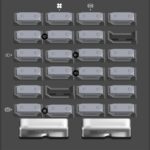The OBD Direct function, easily recognizable by the icon on your diagnostic tool’s home screen, is your gateway to accessing essential vehicle health data using a Generic Obd2 Scanner. This feature is invaluable for understanding basic emission-related issues and gaining initial insights into your car’s condition.
Generic OBD-II/EOBD data provides crucial information related to your vehicle’s emissions system. With a generic OBD2 scanner, you can perform several key diagnostic checks:
- Check for Emission-Related Diagnostic Trouble Codes (DTCs): Identify stored codes that signal potential problems within the emissions system.
- Investigate the Cause of a Malfunction Indicator Lamp (MIL): Determine why your check engine light is illuminated.
- Verify Monitor Status Before Emissions Testing: Ensure your vehicle is ready for official emissions tests by checking the status of various monitors.
- Access the 10 OBD-II Service Modes: Utilize standard service modes for basic diagnostics and information retrieval.
- Examine Readiness Monitor Status: Confirm that the vehicle’s emission control systems have been evaluated.
The strength of the generic OBD2 scanner function lies in its universality. It proves particularly useful when diagnosing vehicles that are not specifically recognized by your diagnostic tool’s enhanced software, or for older OBD-II compliant vehicles. In such cases, you can still retrieve vital generic OBD-II/EOBD codes and data to guide your initial troubleshooting.
However, it’s important to understand the scope of a generic OBD2 scanner. For in-depth analysis of vehicle-specific systems, parameters, and advanced diagnostics, the dedicated “Scanner” function is necessary. This function accesses a broader range of electronic control module (ECM) data beyond the standard generic OBD2 capabilities.
Think of the generic OBD2 scanner as your first step in vehicle diagnostics. It’s excellent for quickly assessing emission-related problems on a wide range of OBD-II/EOBD compliant vehicles, even those not fully supported in your scanner’s database. For more comprehensive diagnostics, remember to utilize the “Scanner” function from your home screen to unlock enhanced OBD-II/EOBD data and vehicle-specific information.
For a visual guide on getting started, refer to this helpful video:
Exploring the OBD Direct Main Menu
Upon selecting OBD Direct, you’ll encounter a main menu with several options designed to streamline your diagnostic process:
- OBD Diagnose: This option provides comprehensive access to vehicle readiness monitors, service modes, trouble codes, and live data. It allows for a detailed examination of the emission system.
- OBD Health Check: For a rapid assessment, the Health Check quickly scans and clears codes, checks readiness monitors, and verifies the MIL status. Ideal for a fast overview of vehicle health.
- OBD Training Mode: Practice and familiarize yourself with the generic OBD-II/EOBD capabilities in a safe environment, without needing to connect to an actual vehicle. This mode is perfect for learning the tool’s functions and menu navigation.
Remember, to effectively use the OBD Direct functions and your generic OBD2 scanner, ensure your Compact Scan Module (CSM) is securely connected to the vehicle and properly communicating with your diagnostic tool. This connection is crucial for accurate data retrieval and reliable diagnostics.
